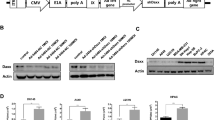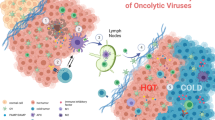Abstract
The pressing challenge for contemporary gene therapy is to deliver enough therapeutic genes to enough cancer cells in vivo. With the aim of improving viral distribution and tumor penetration, we explored the use of decorin to enhance viral spreading and tumor tissue penetration. We generated decorin-expressing replication-incompetent (dl-LacZ-DCNG, dl-LacZ-DCNQ and dl-LacZ-DCNK) and replication-competent (Ad-ΔE1B-DCNG, Ad-ΔE1B-DCNQ and Ad-ΔE1B-DCNK) adenoviruses (Ads). Point mutants of decorin gene (DCNG), DCNK and DCNQ, have a negative and moderate binding affinity to type-I collagen fibril, respectively. In both tumor spheroids and established solid tumors in vivo, tissue penetration potency of dl-LacZ-DCNG was greatly enhanced than those of dl-LacZ, dl-LacZ-DCNQ and dl-LacZ-DCNK, and this enhanced tissue penetration effect derived from decorin-expressing Ad was dependent on the binding affinity of decorin to collagen fibril. Expression of DCNG enhanced viral spread of replicating Ad, leading to improved tumor reduction and survival benefit. Moreover, the tumoricidal effects of Ad-ΔE1B-DCNQ and Ad-ΔE1B-DCNK were lessened, as the binding affinity to collagen was decreased, showing that the increased cancer cell cytotoxicity was driven by the action of decorin on extracellular matrix (ECM). Furthermore, Ad-ΔE1B-DCNG substantially decreased ECM components within the tumor tissue. Finally, intratumoral injection of Ad-ΔE1B-DCNG in primary tumor site greatly reduced the formation of B16BL6 melanoma cell pulmonary metastases in mice. Taken together, these data show the utility of decorin as a dispersion agent and highlight its utility and potential in improving the efficacy of replicating Ad-mediated cancer gene therapy.
This is a preview of subscription content, access via your institution
Access options
Subscribe to this journal
Receive 12 print issues and online access
$259.00 per year
only $21.58 per issue
Buy this article
- Purchase on Springer Link
- Instant access to full article PDF
Prices may be subject to local taxes which are calculated during checkout








Similar content being viewed by others
References
Vile RG, Russell SJ, Lemoine NR . Cancer gene therapy: hard lessons and new courses. Gene Therapy 2000; 7: 2–8.
Roth JA, Cristiano RJ . Gene therapy for cancer: what have we done and where are we going? J Natl Cancer Inst 1997; 89: 21–39.
Runnebaum IB . Basics of cancer gene therapy. Anticancer Res 1997; 17: 2887–2890.
Gomez-Navarro J, Curiel DT, Douglas JT . Gene therapy for cancer. Eur J Cancer 1999; 35: 2039–2057.
Parato KA, Senger D, Forsyth PA, Bell JC . Recent progress in the battle between oncolytic viruses and tumours. Nat Rev Cancer 2005; 5: 965–976.
Harrison D, Sauthoff H, Heitner S, Jagirdar J, Rom WN, Hay JG . Wild-type adenovirus decreases tumor xenograft growth, but despite viral persistence complete tumor responses are rarely achieved--deletion of the viral E1b-19-kD gene increases the viral oncolytic effect. Hum Gene Ther 2001; 12: 1323–1332.
Bischoff JR, Kirn DH, Williams A, Heise C, Horn S, Muna M et al. An adenovirus mutant that replicates selectively in p53-deficient human tumor cells. Science 1996; 274: 373–376.
Kim J, Cho JY, Kim JH, Jung KC, Yun CO . Evaluation of E1B gene-attenuated replicating adenoviruses for cancer gene therapy. Cancer Gene Ther 2002; 9: 725–736.
Kirn D . Clinical research results with dl1520 (Onyx-015), a replication-selective adenovirus for the treatment of cancer: what have we learned? Gene Therapy 2001; 8: 89–98.
Kirn D, Martuza RL, Zwiebel J . Replication-selective virotherapy for cancer: biological principles, risk management and future directions. Nat Med 2001; 7: 781–787.
Liu TC, Galanis E, Kirn D . Clinical trial results with oncolytic virotherapy: a century of promise, a decade of progress. Nat Clin Pract Oncol 2007; 4: 101–117.
Sauthoff H, Hu J, Maca C, Goldman M, Heitner S, Yee H et al. Intratumoral spread of wild-type adenovirus is limited after local injection of human xenograft tumors: virus persists and spreads systemically at late time points. Hum Gene Ther 2003; 14: 425–433.
Kuriyama N, Kuriyama H, Julin CM, Lamborn K, Israel MA . Pretreatment with protease is a useful experimental strategy for enhancing adenovirus-mediated cancer gene therapy. Hum Gene Ther 2000; 11: 2219–2230.
Maillard L, Ziol M, Tahlil O, Le Feuvre C, Feldman LJ, Branellec D et al. Pre-treatment with elastase improves the efficiency of percutaneous adenovirus-mediated gene transfer to the arterial media. Gene Therapy 1998; 5: 1023–1030.
Kim JH, Lee YS, Kim H, Huang JH, Yoon AR, Yun CO . Relaxin expression from tumor-targeting adenoviruses and its intratumoral spread, apoptosis induction, and efficacy. J Natl Cancer Inst 2006; 98: 1482–1493.
Vogel KG, Paulsson M, Heinegard D . Specific inhibition of type I and type II collagen fibrillogenesis by the small proteoglycan of tendon. Biochem J 1984; 223: 587–597.
Yamaguchi Y, Mann DM, Ruoslahti E . Negative regulation of transforming growth factor-beta by the proteoglycan decorin. Nature 1990; 346: 281–284.
Danielson KG, Baribault H, Holmes DF, Graham H, Kadler KE, Iozzo RV . Targeted disruption of decorin leads to abnormal collagen fibril morphology and skin fragility. J Cell Biol 1997; 136: 729–743.
Nareyeck G, Seidler DG, Troyer D, Rauterberg J, Kresse H, Schonherr E . Differential interactions of decorin and decorin mutants with type I and type VI collagens. Eur J Biochem 2004; 271: 3389–3398.
Kresse H, Liszio C, Schonherr E, Fisher LW . Critical role of glutamate in a central leucine-rich repeat of decorin for interaction with type I collagen. J Biol Chem 1997; 272: 18404–18410.
Lang FF, Bruner JM, Fuller GN, Aldape K, Prados MD, Chang S et al. Phase I trial of adenovirus-mediated p53 gene therapy for recurrent glioma: biological and clinical results. J Clin Oncol 2003; 21: 2508–2518.
Li MO, Wan YY, Sanjabi S, Robertson AK, Flavell RA . Transforming growth factor-beta regulation of immune responses. Annu Rev Immunol 2006; 24: 99–146.
Kehrl JH, Wakefield LM, Roberts AB, Jakowlew S, Alvarez-Mon M, Derynck R et al. Production of transforming growth factor beta by human T lymphocytes and its potential role in the regulation of T cell growth. J Exp Med 1986; 163: 1037–1050.
Li MO, Sanjabi S, Flavell RA . Transforming growth factor-beta controls development, homeostasis, and tolerance of T cells by regulatory T cell-dependent and -independent mechanisms. Immunity 2006; 25: 455–471.
Yun CO, Kim E, Koo T, Kim H, Lee YS, Kim JH . ADP-overexpressing adenovirus elicits enhanced cytopathic effect by induction of apoptosis. Cancer Gene Ther 2005; 12: 61–71.
Chartier C, Degryse E, Gantzer M, Dieterle A, Pavirani A, Mehtali M . Efficient generation of recombinant adenovirus vectors by homologous recombination in Escherichia coli. J Virol 1996; 70: 4805–4810.
Yoon AR, Kim JH, Lee YS, Kim H, Yoo JY, Sohn JH et al. Markedly enhanced cytolysis by E1B-19kD-deleted oncolytic adenovirus in combination with cisplatin. Hum Gene Ther 2006; 17: 379–390.
Acknowledgements
This work was supported by grants from the Ministry of Commerce Industry and Energy (10030051, Dr C-O Yun), the Korea Research Foundation (KRF-2005–042-C00148, Dr C-O Yun), the Korea Science and Engineering Foundation (KOSEF) (R01–2006–000–10084–0, R15–2004–024–02001–0, M10416130002–04N1613–00210, Dr C-O Yun) and through its National Nuclear Technology Program (2007–00299, Dr C-O Yun). Il-Kyu Choi is a graduate student sponsored by KOSEF through National Core Research Center for Nanomedical Technology. Young-Sook Lee, Ji Young Yoo and A-Rum Yoon are graduate students sponsored by the Brain Korea 21 Project for Medical Science, Yonsei University College of Medicine, Seoul, South Korea.
Author information
Authors and Affiliations
Corresponding author
Additional information
Supplementary Information accompanies the paper on Gene Therapy website (http://www.nature.com/gt)
Supplementary information
Rights and permissions
About this article
Cite this article
Choi, IK., Lee, YS., Yoo, J. et al. Effect of decorin on overcoming the extracellular matrix barrier for oncolytic virotherapy. Gene Ther 17, 190–201 (2010). https://doi.org/10.1038/gt.2009.142
Received:
Revised:
Accepted:
Published:
Issue Date:
DOI: https://doi.org/10.1038/gt.2009.142
Keywords
This article is cited by
-
Oncolytic virotherapy reverses the immunosuppressive tumor microenvironment and its potential in combination with immunotherapy
Cancer Cell International (2021)
-
Use of cell fusion proteins to enhance adenoviral vector efficacy as an anti-cancer therapeutic
Cancer Gene Therapy (2021)
-
Advances and potential pitfalls of oncolytic viruses expressing immunomodulatory transgene therapy for malignant gliomas
Cell Death & Disease (2020)
-
Optimizing oncolytic virotherapy in cancer treatment
Nature Reviews Drug Discovery (2019)
-
A novel role mediated by adenoviral E1A in suppressing cancer through modulating decorin
Medical Oncology (2019)



